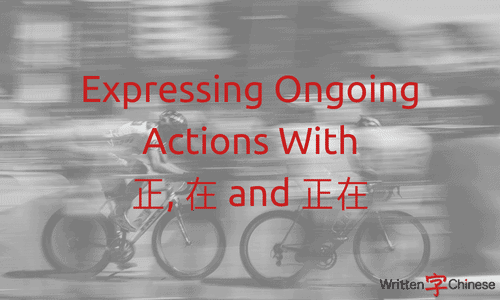正 (zhèng), 在 (zài) and 正在 (zhèng zài) are often associated with expressing an ‘ongoing’ action, but what’s the difference between these three and how do you use them properly?
Learn some sentence patterns with example sentences to help you understand how to express ongoing actions in Chinese!
An Introduction to 正, 在 and 正在
正 (zhèng), 在 (zài) and 正在 (zhèng zài) are used before a verb in a sentence to indicate that an action is ongoing.
Subject + 正 / 在 / 正在 + verb
There are several other ways to suggest the continuation of an action including 着 (zhe) that is used after a verb and 呢 (ne), a particle used at the end of a sentence. 着 (zhe) and 呢 (ne) can be used by themselves in a sentence, but are also found together.

Subject + 正 + verb + 着 + Object + 呢
我的朋友正等着我 (呢)。(wǒ de péng you zhèng děng zhe wǒ (ne)) My friend is waiting for me.

Subject + 在 + verb + 呢
她在写作业 (呢)。(tā zài xiě zuò yè (ne)) She is doing homework.

Subject + 正在 + verb + 着 + Object + 呢
爷爷正在看 (着) 电视 (呢)。(yé ye zhèng zài kàn (zhe) diàn shì (ne)) Grandfather is watching TV.
In some situations they can replace each other interchangeably:
我打电话的时候,我妈正看着我呢。(wǒ dǎ diàn huà de shí hòu, wǒ mā zhèng kàn zhe wǒ ne)
我打电话的时候,我妈在看着我呢。(wǒ dǎ diàn huà de shí hòu, wǒ mā zài kàn zhe wǒ ne)
我打电话的时候,我吗正在看着呢。(wǒ dǎ diàn huà de shí hòu, wǒ mā zhèng zài kàn zhe ne)
My mom is looking at me when I am on the call.
The Differences Between 正, 在 and 正在
The difference between 正, 在 and 正在 in meaning:

正 (zhèng) emphasizes the time of an ongoing action.
在 (zài) emphasizes the status of an ongoing action.
正在 (zhèng zài) focuses on both time and status.
The difference between 正, 在 and 正在 in structure:
正 (zhèng)
Generally, 正 (zhèng) is not used with a normal verb, but can be used within the following sentence pattern:

正 + verb + 着/呢/着呢.
For example:
我们正想。×
我们正想着呢。 √ (wǒ men zhèng xiǎng zhe ne)
We are thinking.
在 (zài) and 正在 (zhèng zài) do not have this limitation and can be used in the following ways:
我们在想。√ (wǒ men zài xiǎng)
我们正在想。√ (wǒ men zhèng zài xiǎng)
We are thinking.
If there is no 着 (zhe) or 呢 (ne) used in the sentence, the verb should be a trending verb, or there should be an object after the verb.
For example:
我们现在正想这个问题。(wǒ men xiàn zài zhèng xiǎng zhè ge wèn tí) We are thinking about the problem now.
她正走过来。(tā zhèng zǒu guò lái) She is walking over.
在 (zài)
The preposition 从 (cóng) (meaning ‘from’) can not used after 在 (zài).
他在从冰箱里拿出一罐啤酒。×
However, neither 正 (zhèng) nor 正在 (zhèng zài) have this issue and can be used with 从 (cóng).
For example:
他正从冰箱里拿出一罐啤酒。√ (tā zhèng cóng bīng xiāng lǐ ná chū yī guàn pí jiǔ)
他正在从冰箱里拿出一罐啤酒。√ (tā zhèng zài cóng bīng xiāng lǐ ná chū yī guàn pí jiǔ)
He is taking a can of beer from the fridge
在 (zài) can be used to express a repeated or ongoing action or a situation that has continued for a long time. In this example, an adverb must come beforehand in the sentence, such as 又 (yòu), 一直 (yī zhí) and 总 (zǒng). This rule does not extend to 正 (zhèng) and 正在 (zhèng zài).
For example:
我一直在等你。√ (wǒ yī zhí zài děng nǐ)
我一直正等你。×
我一直正在等你。×
I am always waiting for you.
Different usage in negation
在 (zài) can be used with both 不 (bù) and 没有 (méi yǒu) for negation.

Subject + 不 / 没有 + 在 + Object
For example:
他不在打球。 (tā bù zài dǎ qiú)
他没有在打球。(tā méi yǒu zài dǎ qiú)
He is not playing basketball.
正在 (zhèng zài) uses 不是 (bú shì) to negate, but can not use 不 (bù) and 没有 (méi yǒu).
The following sentence uses 正在 (zhèng zài) and the negation follows:
他来的时候,你正在吃饭吧。 (tā lái de shí hòu, nǐ zhèng zài chī fàn ba) You were eating when he came.
我不是在吃饭,那时候我已经吃饭了。 (wǒ bú shì zài chī fàn, nà shí hou wǒ yǐ jīng chī fàn le) I wasn’t eating, by then I had already finished.
If you have any questions or comments about expressing ongoing actions, please leave them below!
